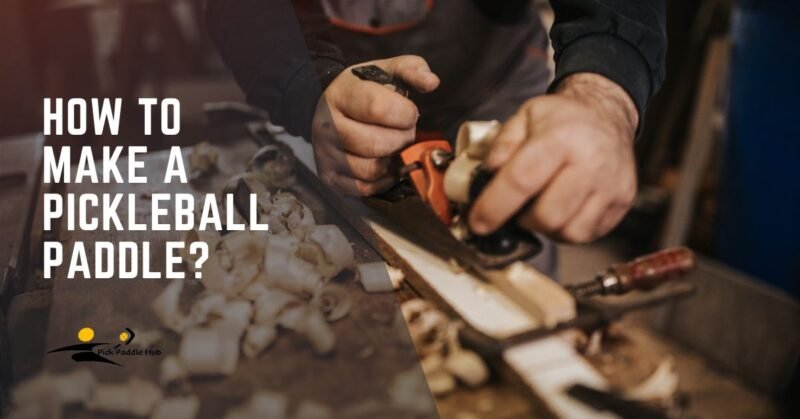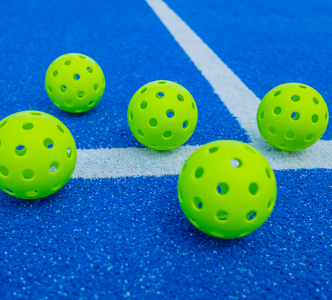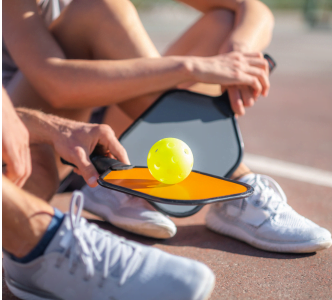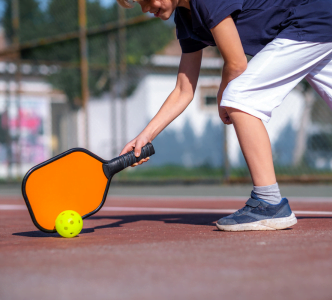Have you ever thought about how to make a pickleball paddle? making a DIY pickleball paddle is a cool project that many players find rewarding.
When you create your homemade pickleball paddle, you get something that perfectly matches your style and needs. Plus, it’s a fun way to connect more with the sport you love.
In this guide, we’ll walk you through why making your DIY paddle is such a great idea. We’ll also give you a clear picture of what the process looks like from start to finish.
Building a pickleball paddle is not just about saving money or having a custom tool for your games. It’s about the satisfaction of playing with something you made with your own hands.
Let’s dive into the journey of making your very own homemade pickleball paddle and discover the joys of DIY craftsmanship in sports.
Pickleball Paddle Template and Construction Quick Guide
This pickleball paddle template serves as a comprehensive guide for anyone looking to design and build their custom pickleball paddle.
It outlines the essential aspects of the paddle’s design and construction, while also providing flexibility for customization based on the player’s specific needs and preferences. Sharing this pickleball paddle outline and design with the pickleball community can offer additional insights and suggestions for refinement, making the process of creating a custom paddle both a personal and communal journey.
Materials and Tools Needed for Making a Pickleball Paddle
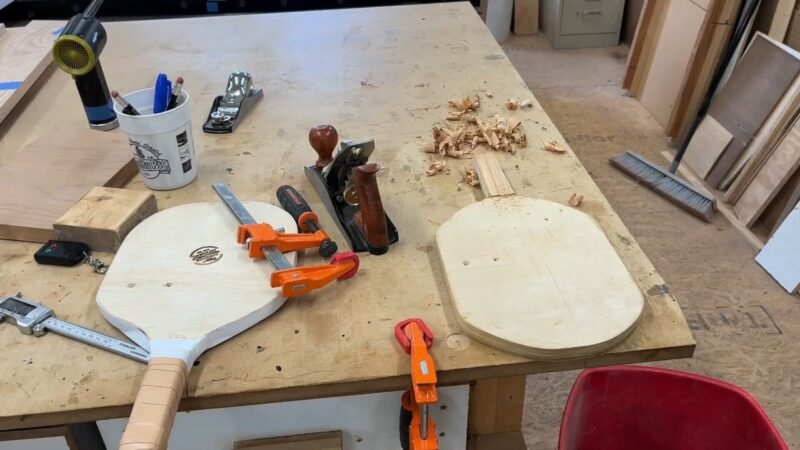
When you decide to make your homemade pickleball paddle, the first step is to gather all the materials and tools you’ll need for the project. Making a DIY pickleball paddle can be a fun and rewarding experience, especially when you play with something you’ve crafted with your own hands. Let’s dive into the types of materials you can use and the tools you’ll need to bring your custom paddle to life.
Materials for Paddle Construction
Pickleball paddles can be made from various materials, each offering different benefits in terms of weight, durability, and playability. Here are the most common materials:
Wood
Wood is the traditional choice for pickleball paddles. It’s affordable and easy to work with, making it a great option for beginners. However, wood paddles are generally heavier and might not provide the same level of performance as those made from more advanced materials.
Composite
Composite paddles are made from a blend of materials, such as fiberglass or carbon fiber, combined with a polymer resin. These paddles are lighter than wood and can be designed to enhance specific playing characteristics, like control or power. Composite materials are a popular choice among players looking for a good balance between performance and price.
Graphite
Graphite paddles are on the higher end of the spectrum. They’re lightweight and offer excellent responsiveness, allowing for precise shots and quick reactions. Graphite is a top choice for competitive players who want the best performance from their paddle.
Tools and Equipment for the DIY Process
Now that you know about the materials, let’s talk about the tools and equipment you’ll need to assemble your paddle:
- Saw: A saw is essential for cutting the wood or composite material to the shape of your paddle. A jigsaw is particularly useful for cutting curves and shaping the paddle to your desired design.
- Sandpaper: Sandpaper helps smooth out the edges and surface of your paddle. You’ll want a variety of grits, from coarse to fine, to ensure a smooth finish.
- Drill: A drill is necessary if you plan to add a handle to your paddle or if you need to make holes for a grip.
- Adhesive: You’ll need a strong adhesive to attach the different layers of your paddle, such as the face material to the core. Epoxy resin is a good choice for its durability and strength.
- Clamps: Clamps are used to hold the materials in place while the adhesive dries. They ensure a tight bond and help keep the paddle flat.
- Measuring Tape and Ruler: Precision is key when making a paddle. A measuring tape and ruler will help you measure and mark your materials accurately.
- Protective Gear: Safety first! Always wear protective gear, such as gloves and safety glasses, when working with tools and materials.
- Paint or Sealant: Once your paddle is assembled, you might want to paint it or apply a sealant to protect it from wear and moisture. This is also your chance to customize the look of your paddle.
How to choose the right shape and size for your playing style
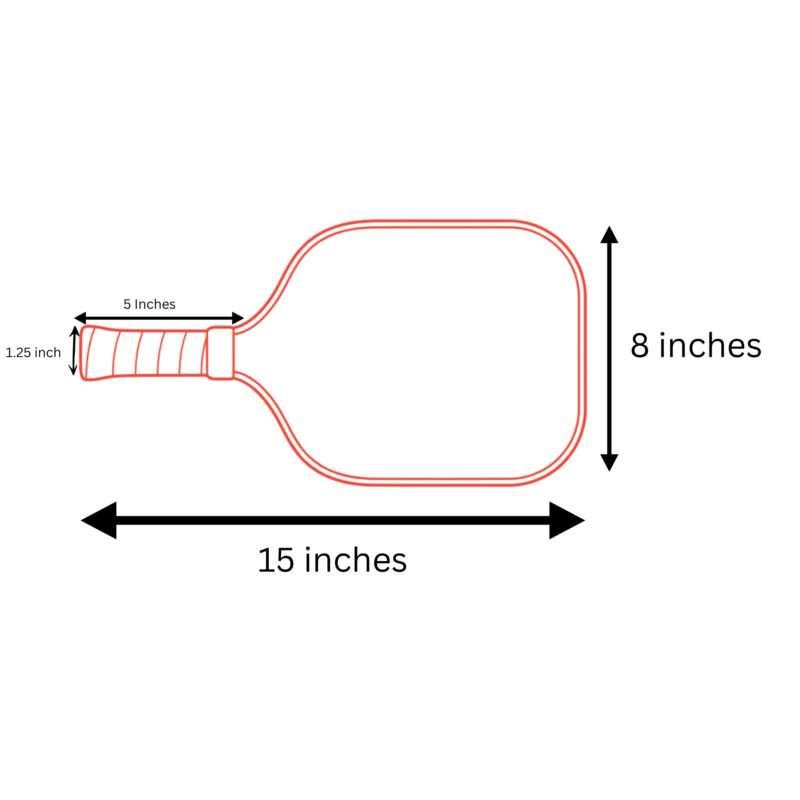
Choosing the right shape and size for your DIY pickleball paddle is crucial because it can significantly affect your game. there are differences between pickleball paddles, the shape of the paddle determines its surface area, which in turn influences your control over the ball and the power of your shots. Generally, a wider paddle offers a more hitting surface, which might be easier for beginners, as it gives them a larger area to hit the ball. On the other hand, a longer paddle can provide more reach on the court, allowing you to hit balls that might otherwise be out of reach, but it might also reduce your control slightly because of the narrower face.
When considering the size of your homemade paddle, think about your playing style. If you’re someone who values precision and likes to place shots with accuracy, a balanced paddle that isn’t too long or too wide might suit you best. Players who prefer power shots and serve might lean towards a slightly longer paddle to gain extra leverage and reach. Remember, the size and shape of the paddle should complement how you play to enhance your strengths on the court.
Considerations for grip size and paddle weight
Grip size and paddle weight are also important considerations. The grip size should comfortably fit in your hand. A grip that’s too large can make the paddle difficult to handle, while a grip that’s too small might not offer enough stability, affecting your shot accuracy. Most paddles come with a standard grip size, but you can always add overgrip tape to adjust the thickness to your preference.
Paddle weight plays a significant role in your gameplay as well. Heavier paddles can generate more power, making them a good choice for players who rely on strong serves and smashes. However, they can also lead to faster fatigue. Lighter paddles offer more control and are easier to maneuver, which can be beneficial for players who prefer a quick, finesse game focusing on placement and spin. It’s all about finding the right balance that suits your physical comfort and playing style.
Step-by-Step Guide To Build Your own Pickleball Paddle
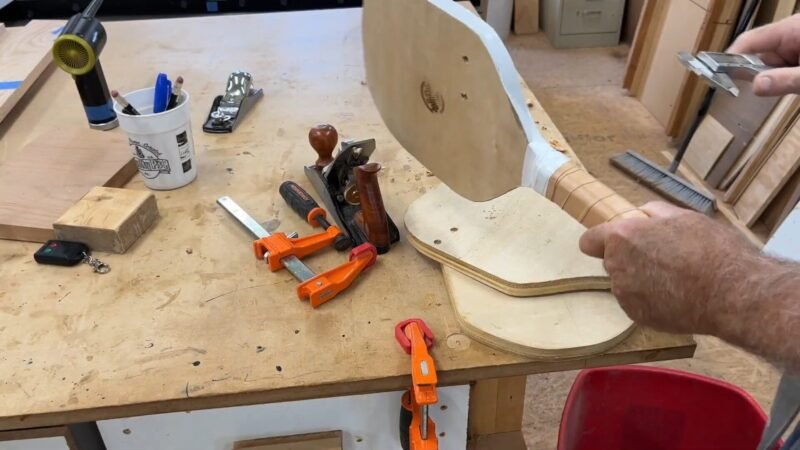
In simple if you want to make your homemade pickleball paddle you need to:
- Sketch your paddle on paper.
- Carefully cut out the shape with a saw.
- Use sandpaper to smooth the edges.
- Cut your chosen surface material and apply.
- Cut and attach the handle to the paddle using an adhesive.
- Sand any rough edges or surfaces for a smooth finish.
Here’s the detailed practical guide:
Step 1: Design Your Paddle
Start by deciding on the dimensions of your paddle. Official regulations require that the combined length and width not exceed 24 inches, with a maximum length of 17 inches. Sketch your design on paper, including the shape of the paddle and the placement of the grip.
Step 2: Select and Cut Your Core Material
Choose your core material—wood, composite, or foam are popular choices. Using your design as a template, trace the outline onto your core material. Carefully cut out the shape with a saw, following the lines closely. If you’re using wood, a jigsaw is ideal for this step.
Step 3: Sand the Edges
Once your paddle shape is cut out, use sandpaper to smooth the edges. Start with a coarser grit to remove any rough spots and gradually move to a finer grit for a smooth finish. This step is crucial for comfort and safety during play.
Step 4: Apply the Surface Material
Cut your chosen surface material—graphite or fiberglass are common options—to the shape of your paddle, leaving a little extra around the edges. Apply a strong adhesive to the core and carefully place the surface material on top. Use a roller or flat tool to remove any air bubbles and ensure a good bond. Trim the excess material once the adhesive has dried.
Step 5: Attach the Handle
For the handle, you can either use a pre-made grip or create one from materials like wood or foam. Attach the handle to the paddle using adhesive, ensuring it’s centered and aligned with the paddle’s shape. Once the adhesive is dry, wrap the handle with grip tape for comfort and to prevent slipping.
Step 6: Add the Edge Guard
An edge guard protects the sides of your paddle and adds durability. Fit the edge guard around the perimeter of the paddle and secure it with adhesive or screws, depending on the type of guard you’re using.
Step 7: Finishing Touches
Sand any rough edges or surfaces for a smooth finish. You can also paint your paddle or add decals for a personalized touch. Finally, apply a sealant to protect against moisture and wear.
Tips for Durability and Compliance
- Choose High-Quality Materials: The durability of your paddle depends on the quality of the materials you use. Invest in good-quality core and surface materials to ensure your paddle lasts longer.
- Compliance with Regulations: Make sure your paddle meets the official size and material regulations if you plan to use it in tournaments. Check the latest guidelines from the USA Pickleball Association (USAPA) to ensure compliance.
- Regular Maintenance: Check your paddle regularly for any signs of wear or damage. Replace the grip tape and edge guard as needed to maintain performance and safety.
Customizing Your Paddle for Performance and Style
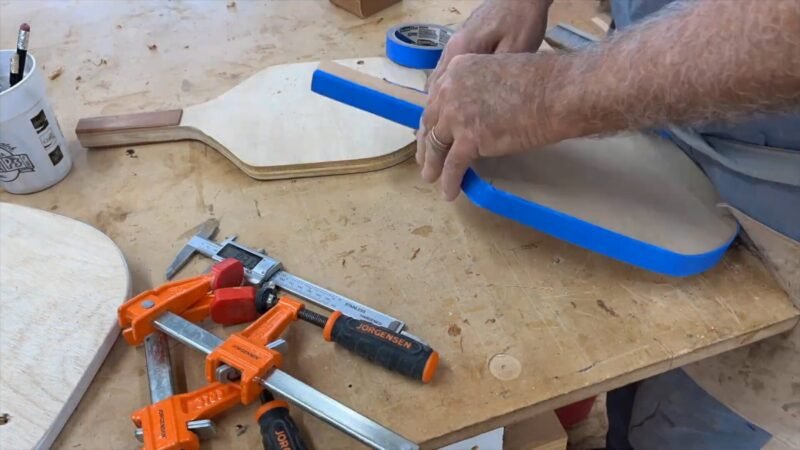
Customizing your pickleball paddle is not just about making it look unique; it’s also about enhancing its performance to match your playing style. By tweaking the design, you can improve aspects like spin, control, and power. Additionally, personalizing its appearance can make the game more enjoyable and let you express your personality on the court. Here’s how you can customize your paddle for both performance and style.
Enhancing Performance
1. Adding Spin
To increase the spin on your paddle, consider using a textured surface material like graphite or composite. These materials can grip the ball better upon contact, allowing you to impart more spin. You can also experiment with different surface treatments or coatings that are designed to enhance grip without violating the sport’s regulations.
2. Improving Control
Control is crucial for precise shot placement. A thicker core can absorb more impact, giving you greater control over the ball’s direction and speed. Materials like polymer are excellent for this purpose. Additionally, the shape of the paddle can influence control; a wider body offers a larger sweet spot, which can be forgiving on off-center hits.
3. Increasing Power
For players looking to add power to their game, the weight and material of the paddle are key factors. A heavier paddle can generate more force, making it easier to hit powerful shots. Materials like carbon fiber and graphite offer a good balance of weight and strength, allowing for powerful strikes without excessive arm fatigue.
Personalizing Appearance
1. Paints
Painting your paddle is a straightforward way to customize its look. Use acrylic paints or spray paints designed for plastics and metals to ensure the paint adheres well and lasts longer. You can apply stencils to create patterns or freehand designs to make your paddle truly one-of-a-kind.
2. Decals and Stickers
Decals and stickers are an easy way to add personal touches to your paddle. From your initials to your favorite quotes or symbols, you can find custom-order decals that reflect your personality. Just make sure they’re securely attached and won’t peel off during play.
3. Finishes
Applying a finish not only protects your custom paint job or decals but can also affect the paddle’s grip on the ball. A matte finish can provide a bit more grip for added spin, while a glossy finish might make the paddle surface smoother. Choose a finish that complements your playing style and the aesthetic look you’re going for.
When customizing your paddle, it’s important to keep official regulations in mind. Ensure that any modifications to the paddle’s surface, especially for performance enhancement, comply with the rules set by the USA Pickleball Association or the governing body of your tournaments. This ensures that your paddle is not only personalized and high-performing but also legal for competition play.
Testing and Adjusting Your Homemade Pickleball Paddle
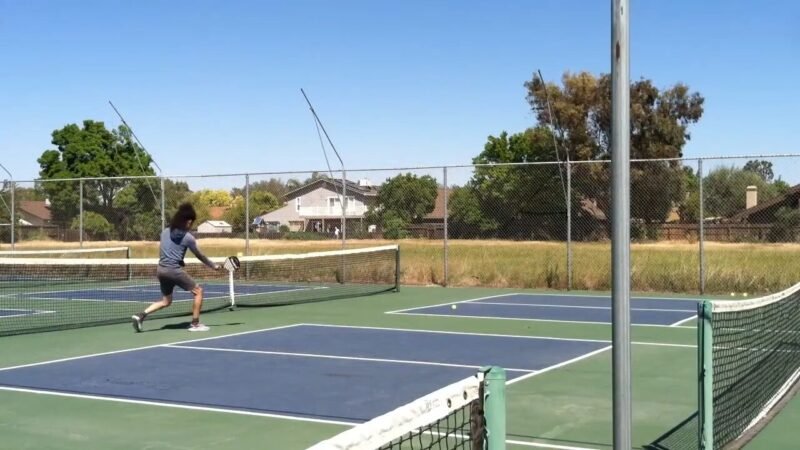
After crafting your homemade pickleball paddle, it’s crucial to test its performance and make any necessary adjustments. This process ensures that your paddle not only meets your expectations but also adheres to safety and playability standards. Here’s how you can evaluate and refine your paddle:
Testing Your Paddle
1. Balance and Feel: Start by assessing the paddle’s balance and how it feels in your hand. A well-balanced paddle should not feel too top-heavy or too light at the handle. You can adjust the balance by adding or removing material from the handle or the head of the paddle.
2. Grip Comfort: Play a few practice games or drills to test the grip’s comfort and size. If the grip feels too small or too large, you can wrap it with an overgrip to adjust the thickness. Ensure the grip material provides adequate slip resistance for safe play.
3. Performance on Court: Focus on how the paddle performs in various shots, including serves, volleys, and smashes. Pay attention to control, power, and spin. If you find any aspect lacking, consider the material and design adjustments. For example, a heavier paddle might increase power, while a textured surface can enhance spin.
Making Adjustments
1. Adjusting Weight: If the paddle feels too light or too heavy, you can adjust its weight by adding or removing materials. Lead tape is a common choice for incrementally increasing weight, especially around the paddle’s perimeter for added power without significantly affecting balance.
2. Surface Modifications: To improve spin or control, you might need to adjust the paddle’s surface. Applying a different finish or adding a new layer of surface material can change how the paddle interacts with the ball. Always ensure that any modifications comply with official regulations.
3. Handle Modifications: The handle’s length and thickness can significantly affect playability. If necessary, you can extend the handle using additional material or adjust the grip size with overgrip tape for better comfort and control.
Safety and Compliance
1. Inspect for Sharp Edges: Ensure that your paddle has no sharp edges or protruding materials that could injure players. Use sandpaper to smooth out any rough areas.
2. Compliance with Regulations: Check the USA Pickleball Association (USAPA) or relevant governing body’s regulations to ensure your paddle meets the required specifications for thickness, length, width, and surface roughness. This is especially important if you plan to use your paddle in official tournaments.
3. Durability Tests: Regularly inspect your paddle for signs of wear or damage, especially after adjustments. Durability is key to safety and performance. If you notice any structural weaknesses, consider reinforcing those areas or making necessary repairs.
Conclusion
Crafting your homemade pickleball paddle is a rewarding journey that blends creativity with technical skill. This pickleball paddle template and step by step process guides you through designing a paddle that not only meets your personal preferences in terms of performance and style but also adheres to official play standards.
By carefully selecting materials, adjusting for balance and weight, and customizing for aesthetics, you create more than just a piece of sports equipment; you forge a personal connection to the game. Sharing your created paddle and experiences with the pickleball community enriches this process, offering insights and fostering a deeper appreciation for the sport and its equipment.
FAQ’s
How do you make a pickleball paddle at home?
Making a pickleball paddle at home involves selecting the right materials (such as wood, composite, or graphite for the core and surface), cutting the material to shape, sanding it to smoothness, attaching a grip, and possibly customizing the paddle with paint or decals. You’ll need tools like a saw, sandpaper, adhesive, and clamps. Following a detailed guide or template can help ensure the paddle meets your needs and complies with regulations.
Can you make a pickleball paddle out of wood?
Yes, you can make a pickleball paddle out of wood. Wood is a traditional material for pickleball paddles and is relatively easy to shape and customize. However, wooden paddles tend to be heavier and may not offer the same level of performance as those made from modern materials like composite or graphite.
Can you 3D print a pickleball paddle?
Yes, it’s possible to 3D print a pickleball paddle, especially the paddle’s core or frame. However, for optimal performance and durability, the surface layer should be finished with a material designed for pickleball, such as graphite or composite. 3D printing allows for high customization but consider the material’s properties and compliance with regulations.
What is a legal pickleball paddle?
A legal pickleball paddle meets the specifications set by the USA Pickleball Association (USAPA) for tournament play. These specifications include limits on length, width, thickness, and surface roughness. The paddle must not contain materials that allow a player to impart undue spin on the ball. Always check the latest USAPA regulations to ensure legality.
Are there fake pickleball paddles?
Yes, like many sports equipment, there can be counterfeit or fake pickleball paddles. These are often imitations of popular brands and models but made with inferior materials and craftsmanship. Buying from reputable dealers and directly from manufacturers can help avoid fake products.
What surface can be used for pickleball?
Pickleball can be played on various surfaces, including concrete, asphalt, wooden gym floors, and synthetic materials designed for sports courts. Outdoor courts are typically made from concrete or asphalt, while indoor courts might use wood or synthetic surfaces. The key is a flat, smooth, and durable surface that allows for consistent ball bounce and player movement.

